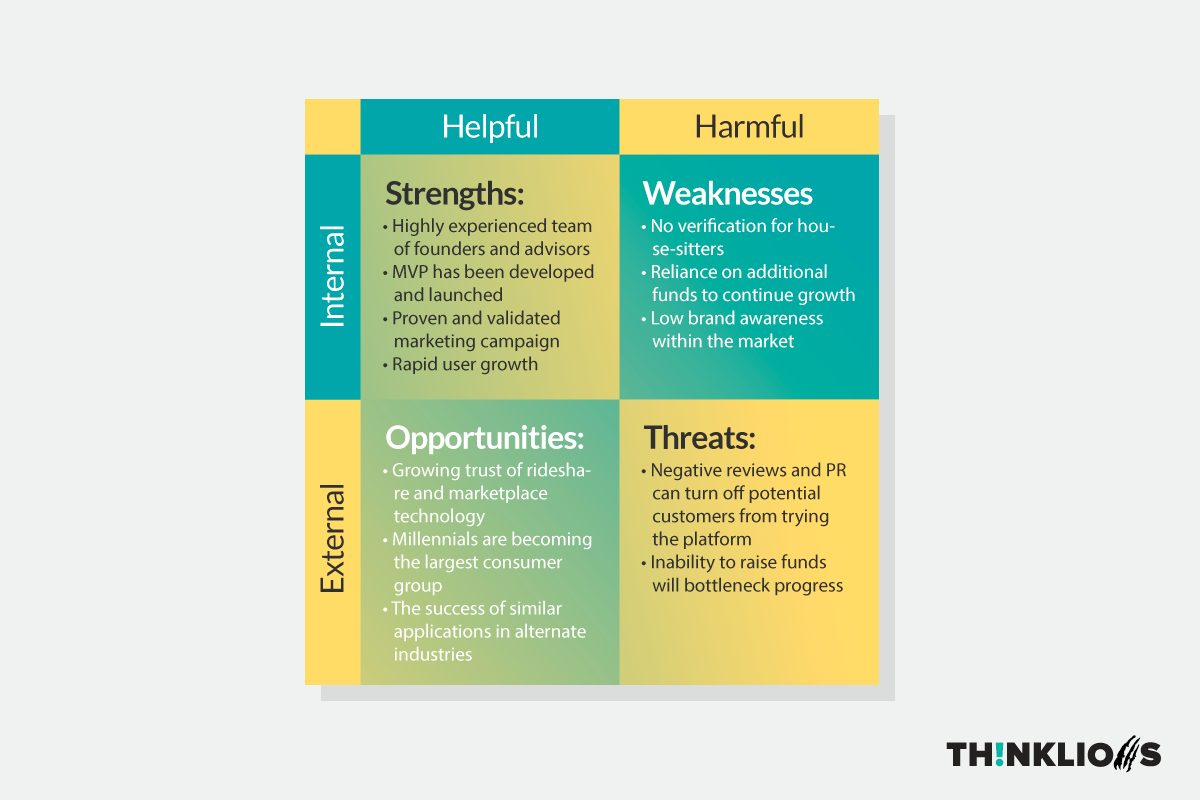Growing a business requires great awareness of how and where you fit within your industry. Knowing what makes your business stand out and where it can improve is vital to long-term success, and being able to answer “what is a SWOT analysis?” also opens you up to learning about the important qualities of your business and market.
In the simplest form, a SWOT analysis is an assessment of a business’s strengths and weaknesses, as well as the opportunities and threats that are apparent within the market.
While a few may seem to come close, the truth is, no business is perfect. No matter how many internal strengths your business has, inevitably, it will also have weaknesses. For example, Facebook may have more users than any other social networking platform, but they also seemingly have widespread dissatisfaction across their workforce.
Likewise, even a business that has the most opportunities to take advantage of will face threats that could stunt their progress or even threaten their entire business. Although Facebook has managed to take advantage of the worldwide growth of internet and smartphone access, they also face major threats – like the inability to keep up with data breaches.
If you’re confused about what a SWOT is or how to create one, don’t worry, your confusion ends today. In this post, you will learn exactly what a SWOT analysis is, why it’s key to writing a business plan, and most importantly, how to put one together.
The SWOT Matrix
Internal factors include strengths and weaknesses – factors that can be controlled and that the business has some ability to change. With the right resources and a commitment to do so, a business can work to gain more strengths and eliminate weaknesses that are present.
The SWOT analysis is typically displayed in a matrix – with internal factors across the top and external factors across the bottom.
External factors include opportunities and threats – factors existing within the market that affect your business. While businesses can control how they respond to these opportunities and threats, they can’t outright control the existence of these factors.
Does Your Business Plan Need a SWOT Analysis?
When you’re creating your business plan, a SWOT is not only necessary – it is the foundation of your entire business plan. Without knowing your strengths, it is impossible to communicate them to your audience. Without knowing your weaknesses, it is impossible to implement the steps necessary to overcome them. Without knowing the market opportunities, it will be impossible to take advantage of them. Without knowing the threats your business may face, it will be impossible to put the right measures in place to avoid them.
It is a wise decision to complete a thorough SWOT analysis before developing your business strategy. In most cases, every business plan format contains some type of SWOT audit. A proper SWOT analysis will require extensive research, but without this research, there will be obvious gaps in your business strategy.
How To Create Your SWOT Analysis

Putting together a SWOT analysis isn’t difficult, but it does require you to perform an in-depth analysis of your business, market, competitors, and industry.
Take your time when you complete your SWOT. Since your entire business strategy hinges upon this analysis, rushing through it is as ineffective as not doing one at all. Instead, follow these tips to best assess the position of your business.
Internal Analysis – Finding Your Strengths
When it comes to a SWOT analysis, strengths represent your company’s competitive advantage and unique selling points. When analyzing the strengths of your business, think about the things that make you stronger than your competitors, the factors that make your business better able to serve consumers, and the barriers to entry that your business has created.
Furthermore, consider the following questions when seeking to find your strengths:
- Are there things that your business does better than anyone else?
- What are your competitive advantages?
- Why is your founding team the right team to manage and grow your business?
- What are your unique selling points?
- Have you accomplished anything that would be a barrier for competitors?
Internal Analysis – Identifying Your Weaknesses
No matter what your business is, weaknesses exist. Many businesses aren’t even aware of their weaknesses – or simply choose not to acknowledge them.
However, weaknesses are an internal factor and can be controlled. When you know your weaknesses, you can better prepare yourself to overcome them; potentially even turning your weakness into strengths.
Consider the areas where your competitors may have a one-up on you. A brand new business, for example, would likely have extremely low brand awareness when compared to a more established business. The same business may not have a proven marketing strategy in place, whereas, a more established business may already have a strong marketing strategy already integrated.
Tinder is a business with many strengths, but like every other business, it is not weakness-proof. “Tinder Fatigue” was coined specifically for this app and refers to users who use the app so much that they burn out on it. Instead of being perceived as a special activity, Tinder dating simply becomes another thing to do; with users simply passing the time instead of seeking long-term romance. While the app has gained worldwide recognition, individuals who are looking for love do not consider it as effective as other online/mobile platforms.
When trying to identify your weaknesses, consider the following questions:
- Which factors prevent you from meeting your goals or catching up to your competitors?
- Are there things that your competitors do better?
- What areas of your business could be improved so you could better serve your customers?
- Are there factors that cause customers to complain or become dissatisfied?
SWOT External – Taking Advantage of Opportunities
Businesses that are able to identify and take advantages of market opportunities are usually able to achieve far greater success. Opportunities are typically out of the business’ control. These are factors that exist that could help your business advance, such as trends in the market or market gaps that competitors are not taking advantage of.
Uber, for instance, realized an opportunity that many others didn’t see. While the taxi business had thrived for decades, Uber’s founders realized that in most areas, the taxi concept was inefficient. Furthermore, they found an opportunity in the fact that most adults have vehicles, and a large enough share of them want to earn additional income. Without recognizing this opportunity and the changing market landscape – rideshare may still not exist today.
When seeking to determine what opportunities exist in the market, consider the following questions:
- What challenges are consumers facing that competitors are not currently addressing?
- Is there any new technology or changes to technological access that may give your business an advantage?
- Are there changes to politics, government, or industry regulations that may give you an additional advantage?
- Can your product/service be used to address a market that you are not currently serving?
- Are there any social trends within the market such as consumer lifestyle changes or growth of a particular market segment?
SWOT External – Managing Threats
Threats are external factors that can hinder your business from progressing or could even cause your business to shut down completely. Fast-food chains, for example, are constantly threatened by the potential for increased federal wage minimums. Since they rely heavily on minimum wage employees, an increase in the federal minimum wage may severely decrease their margins.
Your business will face threats, whether it be threats from new competitors, threats from changing laws, or even the threat of not being able to secure the right partners.
When identifying the threats that exist for your business, consider the following questions:
- Who are your competitors and how easy is it for new competitors to enter the market?
- What are your competitors implementing that you are unable to implement?
- Is your business reliant on a supplier to maintain a specific pricing level?
- Could consumer behavior or market trends change the demand for your product?
- Could advancements in certain technologies make your services irrelevant?
What is a S.W.O.T? (Example)
To give you a better understanding of how a SWOT analysis works, we’ve provided an example from a previous client that worked with.
This particular client had built an online marketplace where people could find a trusted house sitter for durations when they would be on vacation or away. The Company had recently launched a minimal viable product and was seeking to secure capital from an angel investor.

Strengths
There were several great points about the business. They had a highly experienced team and one of their members had already been a founder of a startup that was profitably acquired. With one of their members extremely experienced in digital marketing, they had implemented an effective software marketing campaign that led to quick expansion. Only three months in, they already had thousands of users on their platform, and over 200 transactions had already been fulfilled. Several advisors had committed to helping them and they already had the attention of a handful of investors.
Weaknesses
Unfortunately, not everything was great. Customers complained about the lack of security on the app and wanted added protection that house sitters could be trusted. Although they had an application on the market, it was extremely minimal, and they already burned through their entire development budget. Without additional investor funding, growth was at a standstill.
Opportunities
Although many people were initially off-put by the idea of having strangers watching their home, there were several opportunities apparent in the market. For some, having a stranger house-sit may have seemed weird, but there were already people using online platforms to find individuals to watch their pets, clean their homes, and more. As a result, customer perception of these types of services is quickly shifting, as it is being adopted by more and more consumers. Of their current users, the vast majority were millennials – which is perfect since millennials are growing to become the country’s largest consumer group.
Threats
The Company also faced several potential threats that could possibly derail them if not addressed. Customers had a point with their feedback regarding home security. In fact, if there ever was a major security threat related to the business, it could lead to a PR nightmare. Another major threat was also apparent – their financial well had run dry, and without additional funds, the business would be unable to go forward.
After examining these factors, our business plan writers created the following SWOT analysis for our client.
From SWOT to Strategy
Knowing what SWOT stands for isn’t enough. Real progress is made when you are able to use this analysis to your advantage.
Keep building upon your strengths. Your strengths give you a competitive advantage, and the more strengths you have, the harder it becomes for other businesses to compete.
Work to minimize your weaknesses. Find solutions to them, and make it a constant goal to strengthen your weaknesses. If done correctly, today’s weaknesses can become tomorrow’s strengths.
Always pay attention to the opportunities and threats in the market. Prioritize opportunities and attack them one by one to exponentially grow your business. Stay ahead of your threats. Once you have identified them, find ways to avoid them or determine a Plan B ahead of time in case you need to pivot in response.
As always, if you need our help in creating your SWOT analysis or writing your entire business plan, we are here for you. Contact us today to consult with one of our business plan experts!



